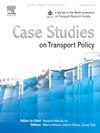Will citizen participatory transport policies affect people to use cars less? Empirical evidence from car-free day project in South Korea
IF 2.4
Q3 TRANSPORTATION
引用次数: 0
Abstract
Many cities worldwide are beginning to focus on the Car-Free Policy to increase urban spaces and create sustainable cities considering the public demand for open space. However, existing studies suggest that the car-free day’s operating factors and guidelines focus solely on quantitative data of effectiveness. However, existing studies suggest that the car-free day’s operating factor and guidelines only bring quantitative data of effectiveness to a halt. Therefore, the analysis of the user perception and behavioral change according to the car-free day operation, and the impact of each factor of the event is insufficient. This study analyzes the user perceptions and behavioral changes according to 10 car-free days in Suwon. Using the data collected from the research, we propose improvement strategies by verifying behavioral changes with user perception. We divide 24 measured variables into six categories: types of event, event operation, infrastructure, change in perception, mobility patterns, and visiting hours. Further, this research sets three premises for the proposal, followed by nine hypotheses to determine the further study of the relationship between customer satisfaction, user perception, and behavioral changes according to the car-free day operation. Using structural equation models and examining path analysis, the user perception is mainly influenced by user satisfaction, satisfaction with transportation and infrastructure, and behavioral change is mainly influenced by factors such as visiting hours and changes in perception. This research identified the detailed factors influencing user perception and behavioral change according to a car-free day operation and aims to contribute to the establishment of activating car-free streets. Moreover, the car-free days in Suwon city increased, and by including cohort research methods, further research can be conducted to determine whether car-free days actually cause behavioral changes and whether user perception is improved every year.
公民参与式交通政策会影响人们减少使用汽车吗?来自韩国无车日项目的经验证据
考虑到公众对开放空间的需求,世界上许多城市开始关注无车政策,以增加城市空间,创造可持续发展的城市。然而,现有的研究表明,无车日的操作因素和指导方针只关注有效性的定量数据。然而,现有的研究表明,无车日的操作因素和指导方针只能使有效性的定量数据停滞不前。因此,根据无车日运营来分析用户感知和行为变化,以及各因素对事件的影响是不够的。该研究分析了水原市10天无车的情况下,用户的感受和行为变化。利用从研究中收集的数据,我们通过验证用户感知的行为变化来提出改进策略。我们将24个测量变量分为6类:事件类型、事件操作、基础设施、感知变化、移动模式和访问时间。进一步,本研究为提案设定了三个前提,随后提出了九个假设,以确定根据无车日运营进一步研究客户满意度、用户感知和行为变化之间的关系。利用结构方程模型和检验路径分析,用户感知主要受用户满意度、交通满意度和基础设施满意度的影响,行为改变主要受访问时间和感知变化等因素的影响。本研究通过一个无车日的运行,找出影响用户感知和行为改变的具体因素,旨在为激活无车街道的建立做出贡献。此外,水原市的无车天数也在增加,通过纳入队列研究方法,可以进一步研究无车天数是否真的导致了行为变化,以及用户的感知是否每年都在改善。
本文章由计算机程序翻译,如有差异,请以英文原文为准。
求助全文
约1分钟内获得全文
求助全文

 求助内容:
求助内容: 应助结果提醒方式:
应助结果提醒方式:


